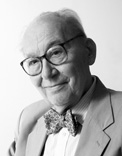- Skip to:
- (M) Main Content
FIRM
Staff

Jan Hird Pokorny
In Memoriam
Jan Hird Pokorny, New York architect, preservationist, and former commissioner on New York’s Landmarks Preservation Commission, died May 20, 2008 at his home in Manhattan. He was 93.
Born in 1914 in Brno, Czechoslovakia, he was educated and raised in Prague. In 1932 he entered the School of Architecture and Civil Engineering at the Czech Technical University in Prague graduating in 1937.
Shortly after graduation Pokorny practiced architecture briefly in Czechoslovakia designing the Sykovec Hotel in the Czech-Moravian Highlands. In August of 1939 at the outbreak of World War II, Pokorny fled the German occupation of Czechoslovakia and six months later arrived at Ellis Island on a student visa to begin a new life in New York City.
Although he had already received full architectural training in Europe, Pokorny enrolled at Columbia University’s School of Architecture where he earned a Masters degree in two years. In 1945 he acquired full American citizenship. In 1946 he returned to Columbia University to participate as a design critic, re-establishing a vigorous relationship with the institution that had sheltered him as a war émigré. He continued to serve on the faculty for over 50 years.
During World War II Pokorny also served as a designer for the military in Detroit. After a brief period with the office of Skidmore, Owings & Merrill in the mid 1940s, Pokorny opened a firm with his then wife, Elizabeth Hird. A major commission in 1949 to design a student union and library at Centenary College in Hackettstown, New Jersey, gained the firm notice and began a string of successful commissions designing institutional and private buildings and interiors. Among them were Buttinger Library in Manhattan; the School of General Studies at Lewisohn Hall on the Columbia University Campus; a master plan for the State University at Stony Brook followed by the student union, library and administration buildings there. Pokorny also designed a master plan for Lehman College in the Bronx, followed by a central campus facility, library, speech, theater and auditorium buildings. The acoustics of the auditorium were praised by the New Yorker as being second only to those of Carnegie Hall.
As a designer, Pokorny’s style was modern and lean. He avoided grandiose statements and instead relied on a humanistic appreciation of scale, materials, and context. He was influenced by his upbringing in Czechoslovakia and by the time he spent in Scandinavia and Japan. He was also heavily influenced by his fellow countryman, friend and architect, Antonin Raymond. His interiors were notable for their functionality, rational plans, sensitive lighting, and a warm tactile quality achieved through use of natural wood and textured surfaces. His townhouse on East 51st Street in Manhattan embodied all of these hallmarks. The townhouse contained his architectural office which at times housed a dozen employees. The office remained on East 51st Street until 2005 and came to epitomize the relaxed, familial feel of the firm. Monthly staff meetings were held in the living room, with employees gathering on Nakashima and Pokorny-designed furniture.
In the early 1960s, a commission to redesign the historic Lewisohn Hall at Columbia University brought out Pokorny’s latent preservationist instincts and laid the groundwork for his later shift toward preservation architecture. While many architects would have lobbied for wholesale changes, exterior alterations, or the construction of a new building altogether, Pokorny left Lewisohn’s exterior intact, reworking the interior to accommodate new programmatic requirements. The result was a beautiful, functional, modern interior and an exterior that retained visual continuity with the campus as a whole. The project came to the attention of James Marston Fitch, a colleague and a pioneer of the preservation movement, who admired the project for its restraint and fine interior plan, and characterized it as a successful “adaptive use,” the first of many that Pokorny would perform in the coming years. He subsequently joined the faculty of Fitch’s historic preservation program at Columbia University, where he served for 38 years.
Pokorny’s firm has become well-known as an office specializing in historic preservation, completing major commissions including the restoration of the Schermerhorn Row block at the South Street Seaport in lower Manhattan, restoration of the rotunda and dome of the New Jersey State House in Trenton, restoration of the Fireman’s Memorial in Riverside Park, restoration of the Battery Maritime Building in Lower Manhattan, restoration of the Brooklyn Historical Society building in Brooklyn Heights, and restoration of one of the historic Bund buildings in Shanghai.
Pokorny also served on the Art Commission of the City of New York from 1973 to 1977. From 1997 to 2007 Pokorny served as the senior commissioner on the New York City Landmarks Preservation Commission. He felt that his service on the Landmarks Commission played an important role in encouraging new design while protecting historic buildings and districts in the City.
Pokorny became characterized later in his career as the quintessential architect in New York City. Numerous awards were bestowed upon him by colleagues and professional organizations. However, despite an active professional life in New York, Pokorny retained strong ties to his native Czechoslovakia and his personal identity was inextricably linked to old-world Europe. In manner, dress, speech, and in his respectful, diplomatic treatment of others, Pokorny embodied the idea of an aristocratic European gentleman taking seriously his responsibility as a figurehead of the Czech émigré community and de-facto “cultural ambassador” of the Czech Republic in New York.
His mastery of design, studied professionalism and genteel, soft-spoken manner as well as his dedication to architectural education garnered him the respect of his colleagues, and the love of his students and staff.
He is survived by his second wife of 43 years, Marise Angelucci-Pokorny, and their son Stefan Pokorny.
- Firm Categories
Staff bios:
Select name
To email a staff member at Jan Hird Pokorny Associates please use the format lastname@jhpokorny.com